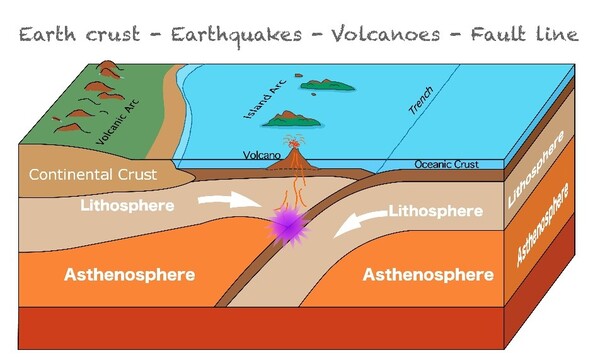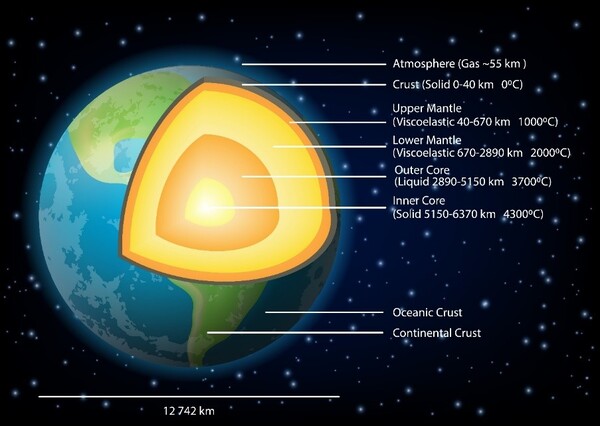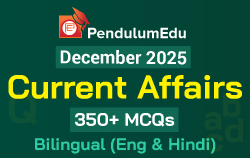Internal structure of Earth - Crust, Mantle and Core | What's inside Earth?
The basic understanding of the structure of Earth will help one learn other concepts well like earthquakes, plate tectonic theory, volcanoes, landforms, etc. In this study material, many important facts about Earth's interior are discussed. The structure of the Earth, layers in Earth interior, etc. are given below:
1. Interior of the Earth
Earth has been formed about 4500 million years ago. Its radius is 6371 km. What’s inside the earth can be known through the information obtained through direct observations and analysis of materials. There are two sources of information: Direct and Indirect Sources.
Direct Sources: Mining, Deep Ocean Drilling Projects, Volcanic Eruptions
Indirect Sources: Analysis of the rate of change of temperature and pressure from the surface to interior of the earth, Meteors, Gravitation, Magnetic field and Seismic activity (Shadow zones of Primary and Secondary waves)
The temperature increases with an increase in depth. However, the rate of increase of temperature from the earth’s surface towards the centre is not uniform. The rate of increase is 1°C for every 32 m increase in depth for the first few km, and then going towards the centre the rate of increase of temperature declines. Similarly, the pressure also increases as we move towards the centre of the earth. Due to high pressure and the presence of materials like Iron and Nickel, the density of layers increases as we move towards the centre.

Fig.1: Internal Structure of Earth
2. Layers of Earth’s interior
The interior structure of the earth is divided into three layers. These are as follows:
2.1 Crust:
It is the outermost layer of the earth. It is the thinnest of all layers of earth. It is brittle in nature. The crust is divided into plates that float on the mantle. It is made up of different types of solid rocks and minerals. It constitutes only 1% of the entire volume of the Earth. Its average thickness is 30 km.
Types of Crust: There are two very different types of crust- Oceanic crust and Continental crust. Oceanic crust (mean thickness: 5 km) is thinner than continental crust (mean thickness: around 30 km). Oceanic crust is denser than the continental crust.
- 2.1.1 Continental Crust: The continental crust is composed of sodium potassium aluminium silicate rocks. It is mainly made up of silica and alumina and hence, called sial (si-silica & al-alumina). Its average density is about 2.7 g/cm3.

Fig.2: Continental Crust and Oceanic Crust
- 2.1.2 Oceanic Crust: The oceanic crust is composed of dense iron magnesium silicate igneous rocks. It is mainly made up of silica and magnesium and hence, called sima (si-silica & ma-magnesium). Its average density is about 3 g/cm3. It is constantly formed at mid-ocean ridges and destroyed at subduction zones. Therefore, the oceanic crust is younger than the continental crust.
The Conrad discontinuity is the boundary between the hydrosphere and crust.
The Mohorovicic discontinuity is the boundary between the crust and the mantle. This is a depth where seismic waves change velocity.
The lithosphere is made up of the crust and the uppermost part of the mantle.
2.2 Mantle:
- It is the layer between the core and crust. Its upper portion is called the asthenosphere.
- Asthenosphere is the main source of magma over which continental plates move.
- The density of this layer varies from 3.3 to 5.7 g/cm3.
- It constitutes about 84 percent volume of the earth. It is about 2,900 kilometers thick.
- Most of the rocks that make up the mantle are silicates. Another major type of rock present is magnesium oxide.
- Other elements found in the mantle are: Iron, Aluminium, Calcium, Sodium and Potassium.
- Repetti discontinuity is the boundary between the upper mantle and the lower mantle.
- Pyrosphere is the middle zone of the interior of the earth with a thickness of 2780 km. It is located between the lithosphere and the barysphere. It is the zone of igneous activity and lava formation.
2.3 Core:
- The innermost layer of the earth is called the core. It is around 3500 km in radius.
- It is the densest layer of the earth. Its average density ranges from 9.5 to 14.5 g/cm3.
- Its main constituent elements are iron and nickel. Hence, it is known as Nife (Ni – nickel & Fe – ferrous i.e. iron) layer.
- The earth's core is divided into two parts: the liquid outer core and the solid inner core. The temperature of the core is around 5000 degrees Celsius.
- The high temperature is mainly due to residual heat from Earth’s formation, heat generated by gravitational forces from the sun and moon and the radioactive decay of elements present inside the Earth.
- At such a high temperature, the materials are in a solid state due to the high pressure of the overlying materials.
- It was discovered in 1906 by R.D. Oldham. It constitutes about 1 percent volume of the earth.
- The boundary between the mantle and core is known as Guttenberg’s discontinuity.
- Baryshpere is the innermost zone of the interior of the earth.

Fig.3: Internal Structure of Earth
Need to Know Facts:
- The deepest mine in the world is located in South Africa. Mponeng Gold Mine is located south-west of Johannesburg in South Africa.
- Kolar Gold mine was the deepest mine in India.
- Earth’s magnetic field is due to the flow of molten iron and nickel (present in earth’s outer core) around the inner core.
- Near the Moho discontinuity, the temperature of the crust varies from 200 degree Celsius to 400 degree Celsius.
- Motohiko Murakami, Professor of Experimental Mineral Physics, and his team proved the hypothesis that there is variation in the composition of lower mantle and upper mantle.
Summary
Earth: Formed about 4500 million years ago, radius 6371 km.
Crust: Earth’s outermost and thinnest layer, brittle in nature, Mohorovicic discontinuity (boundary between crust and mantle), Lithosphere (crust and uppermost part of mantle).
Continental Crust: mean thickness: around 30 km, called sial as made up of silica (si) and alumina (al).
Oceanic Crust: mean thickness: 5 km, called sima as made up of silica (si) and magnesium (ma).
Mantle: makes 84% of volume of earth, asthenosphere (upper layer of mantle), Repetti discontinuity (boundary between upper mantle & lower mantle).
Core: Earth’s innermost and densest layer, called nife as mainly made up of nickel (ni) and iron (fe), discovered by R.D. Oldham.
Pyrosphere: located between lithosphere and barysphere, zone of igneous activity and lava formation
Baryshpere: innermost zone of the interior of the earth




 Latest
Latest 



Comments